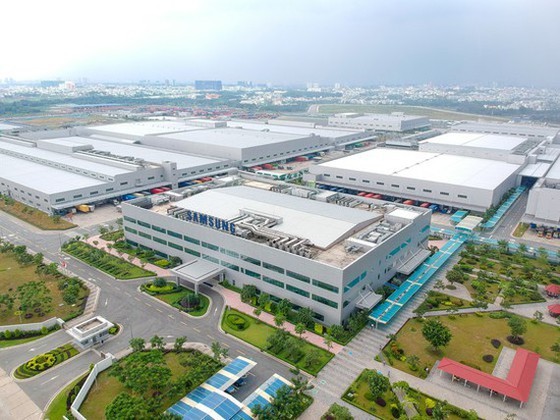
This information has initially eased the concerns in the context of a difficult economy, while Samsung is the largest foreign investor in Vietnam with a total investment of over US$17.3 billion. Not only making a great economic contribution, but Samsung Vietnam is also creating stable jobs for 130,000 employees.
However, India is indeed inviting giant tech corporations with the greatest preferential treatment ever. More than a month ago, this country announced a special package of preferential production policies, worth up to $5.5 billion, to support five mobile phone manufacturing companies with an accumulated investment of over $133 million in four years, counting from April, and revenue posting growth year by year.
The support package pays in cash for high-end products, valued at over $200 per item. This means that enterprises producing high-end products, such as Apple or Samsung, can receive the highest support of up to $1.1 billion within five years, or about $220 million per year.
Adding to the risk of losing investment in Vietnam is the fact that Samsung already has two factories in India. Of which, the factory in Noida put into operation in 2018 is one of the largest mobile phone factories of Samsung globally, with an annual capacity of 120 million devices.
Although attracting investment with financial incentives is not new, and Vietnam also used to successfully apply financial support of $70 million to Intel 14 years ago, which many experts jokingly said as throwing a sprat to catch a whale.
After Intel decided to enter Vietnam, several large foreign technology groups have followed. But this time, with the daring move of India, perhaps, Vietnam must find another way.
Professor - Doctor of Science Nguyen Mai, Chairman of Vietnam’s Association of Foreign Invested Enterprises, said that a few years ago when Samsung opened a large-scale factory in India, there were concerns about the possibility that the global largest mobile phone producer would shift its production to India. However, Samsung's factory in India mostly produces to serve the market of nearly 1.4 billion people in this country. Only a small proportion of its production is for export.
Meanwhile, in Vietnam, according to Samsung’s leader, besides manufacturing, the group also focuses on the field of research and development (R&D). The R&D center in Tay Ho Tay is currently under construction, expected to be completed by the end of 2022 and will increase the human resources from the current 2,200 people to 3,000 people to provide high-quality human resources to develop new technologies, such as 5G, AI, and Big Data.
So, if Vietnam grasps the strategies and policies of investors and takes wise steps, Vietnam can still be chosen. Minister of the Ministry of Planning and Investment Nguyen Chi Dung said that Vietnam inherently has many outstanding advantages. The country is also developing a new strategy for foreign investment attraction.
Many outstanding preferential mechanisms and policies are being studied at the same time with the preparation of infrastructure, land, and human resources to best meet the needs of investors. If that strategy realizes soon, opportunities will still wide open for Vietnam.
However, India is indeed inviting giant tech corporations with the greatest preferential treatment ever. More than a month ago, this country announced a special package of preferential production policies, worth up to $5.5 billion, to support five mobile phone manufacturing companies with an accumulated investment of over $133 million in four years, counting from April, and revenue posting growth year by year.
The support package pays in cash for high-end products, valued at over $200 per item. This means that enterprises producing high-end products, such as Apple or Samsung, can receive the highest support of up to $1.1 billion within five years, or about $220 million per year.
Adding to the risk of losing investment in Vietnam is the fact that Samsung already has two factories in India. Of which, the factory in Noida put into operation in 2018 is one of the largest mobile phone factories of Samsung globally, with an annual capacity of 120 million devices.
Although attracting investment with financial incentives is not new, and Vietnam also used to successfully apply financial support of $70 million to Intel 14 years ago, which many experts jokingly said as throwing a sprat to catch a whale.
After Intel decided to enter Vietnam, several large foreign technology groups have followed. But this time, with the daring move of India, perhaps, Vietnam must find another way.
Professor - Doctor of Science Nguyen Mai, Chairman of Vietnam’s Association of Foreign Invested Enterprises, said that a few years ago when Samsung opened a large-scale factory in India, there were concerns about the possibility that the global largest mobile phone producer would shift its production to India. However, Samsung's factory in India mostly produces to serve the market of nearly 1.4 billion people in this country. Only a small proportion of its production is for export.
Meanwhile, in Vietnam, according to Samsung’s leader, besides manufacturing, the group also focuses on the field of research and development (R&D). The R&D center in Tay Ho Tay is currently under construction, expected to be completed by the end of 2022 and will increase the human resources from the current 2,200 people to 3,000 people to provide high-quality human resources to develop new technologies, such as 5G, AI, and Big Data.
So, if Vietnam grasps the strategies and policies of investors and takes wise steps, Vietnam can still be chosen. Minister of the Ministry of Planning and Investment Nguyen Chi Dung said that Vietnam inherently has many outstanding advantages. The country is also developing a new strategy for foreign investment attraction.
Many outstanding preferential mechanisms and policies are being studied at the same time with the preparation of infrastructure, land, and human resources to best meet the needs of investors. If that strategy realizes soon, opportunities will still wide open for Vietnam.
























